
Fish Feed Manufacturing Plant
The fish feed manufacturing plant is a complete system that processes various raw materials into high-quality fish feed. It includes multiple machines and manufacturing steps, ensuring efficient and energy-saving production that supports the development of modern aquaculture and aligns with green energy goals.
RICHI Machinery specializes in complete fish feed production solutions, offering customized equipment and processes to meet different pellet size and nutrition needs. Our feed lines play a key role in improving fish growth, promoting sustainable aquaculture, and advancing industry development.
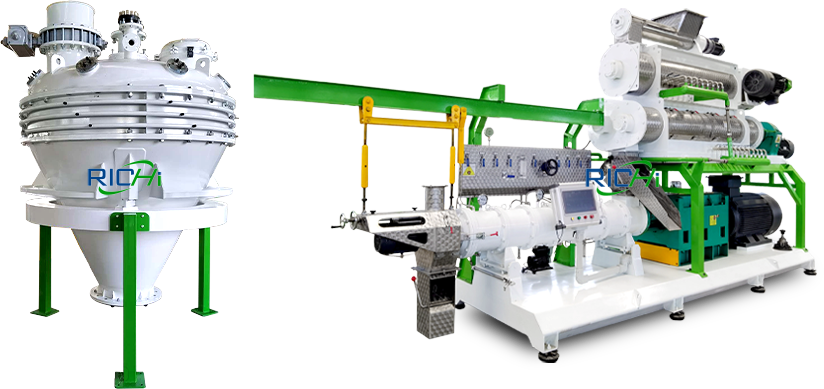
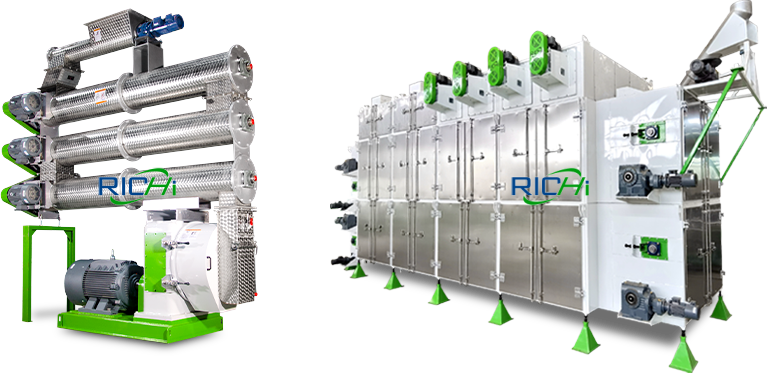
What is a Fish Feed Manufacturing Plant?
The fish feed production line is a modern production equipment used to produce various fish feed, pet feed and shrimp feed. The production line can efficiently produce high-energy fish feed. It has intelligent and highly configured production equipment and manufacturing processes, consisting of a receiving system, crushing system, mixing system, granulation system, drying system, cooling system, screening system, and automatic packaging system. This production line is conducive to precisely controlling the size and quality of fish feed pellets, better controlling maturity, improving maturity, and thus improving the digestion and absorption rate of aquatic animals.
What is the fish feed manufacturing plant used for?
— Richi Machinery —
The fish feed production plant is widely used in aquaculture. The production line can be used in freshwater fish, seawater fish and shrimp breeding fields, as well as the production of floating fish feed, sinking fish feed, and shrimp feed. The following briefly lists the common application areas:
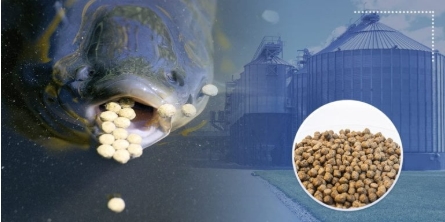
Floating Fish Feed
It is mainly suitable for some fish that move in the middle and upper layers, such as common grass carp and bream. These fish usually feed in the upper and middle layers of the water body, and floating feed can facilitate them to find and ingest food in time. Moreover, farmers can visually see the feeding status of the fish, reasonably adjust the feeding amount, and avoid feed waste.
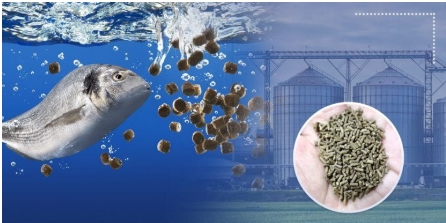
Sinking Fish Feed
Suitable for fish living at the bottom of the water body, such as carp, black carp, etc. They are used to looking for food at the bottom of the water. Sinking feed can meet their feeding habits, ensure that the feed can reach their activity area, ensure nutrient intake, and also reduce the loss of feed in the upper and middle layers of the water body.
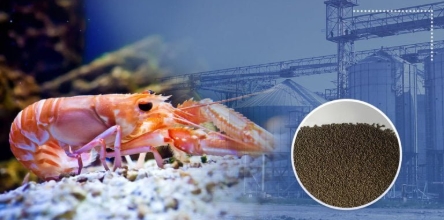
Shrimp Feed
Suitable for a variety of shrimps, such as white shrimp, crayfish, etc. Shrimp feeding methods are different from fish. Shrimp feed will specifically add substances needed for shrimp growth in terms of nutrients, such as astaxanthin, etc., to meet the physiological needs of shrimp, help shrimp grow healthily, shed shells, etc., and improve breeding efficiency.
RICHI MACHINERY
Benefits of fish feed pellets
Fish feed pellets processed through the fish feed manufacturing unit have a variety of benefits. For example, fish feed pellets are nutritious, easy to digest and absorb, and can promote the healthy and high-quality growth of fish. Let’s take a look at what benefits it has.

Fish feed pellets are high in energy and rich in protein, fat, and carbohydrates. This balanced nutrition improves fish meat quality, strengthens immunity, and promotes healthy, efficient growth. The pellets are also fully cooked under high temperature and pressure, making nutrients easier to digest and absorb while reducing feed waste.

Compared to other feed types, pellets have a compact and uniform shape, allowing for efficient storage and transportation. When kept in a cool, dry, and covered space, they can be stored safely for 2 to 3 months, significantly reducing feed spoilage and loss.

The high-temperature, high-pressure manufacturing process helps eliminate harmful bacteria and pathogens present in raw materials, ensuring safer and more hygienic feed for aquatic animals.

Fish feed pellets can be made from a wide variety of raw materials and customized in different sizes and densities to suit various species and growth stages. Their wide application, ease of production, and profitability make them highly attractive in both local and international aquaculture markets.
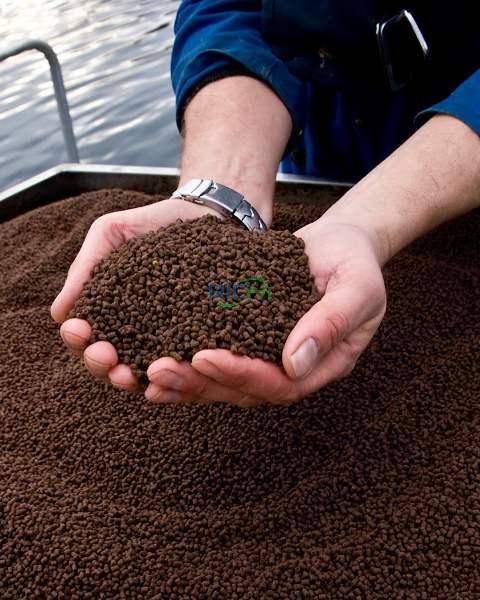
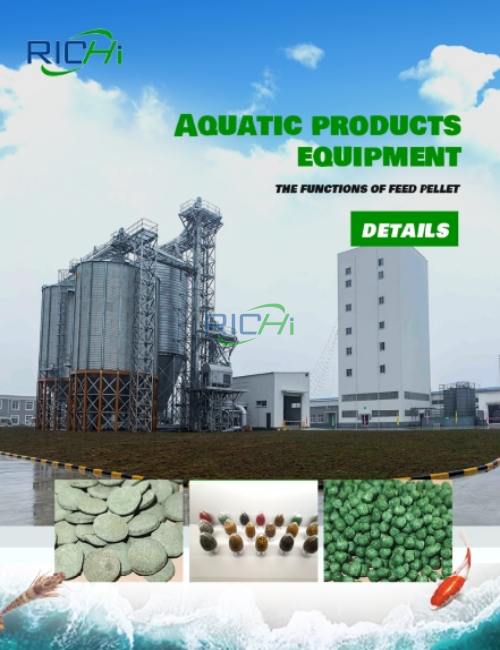
Characteristics of fish feed manufacturing plant
The main function of the fish feed production plant equipment is to process various raw materials into feed suitable for fish feed through mixing, crushing, granulation and other processes.
(1) The production line adopts fully automated control and variable frequency speed control system. The production speed can be adjusted according to the user’s own production needs. It can produce feed continuously and stably, greatly improving production efficiency.
(2) RICHI Machinery will provide a complete set of fish feed pellet production procedures, adopting advanced technology, and the production capacity of the production line can range from 1 to 60 tons/hour according to customer needs. The design is designed with energy saving in mind and optimized energy use. It has the advantages of high production capacity, low noise, and low energy consumption, which helps to reduce operating costs.
(3) Raw materials are widely applicable, and can process a variety of feed raw materials to produce various animal feed pellets, such as shrimp feed pellets, crab feed pellets, fish feed pellets, etc. Processed fish feed pellets have high hardness, smooth surface and internal maturation, which can improve the digestion and absorption of nutrients, achieve optimal digestion and reduce waste.
(4) Fish feed mill plant has high production efficiency, high power strength, and a long service life. In terms of design, we pay attention to the hygiene of raw materials and the sealing nature of the processing process to ensure that the feed is not contaminated and ensure the health of fish.
RICHI MACHINERY
Introduction to the main equipment of fish feed manufacturing plant
Floating fish feed extruder machine is one of the core equipment of the fish feed manufacturing unit. It can produce high-quality feed pellets for a variety of types of aquatic animals, such as fish feed pellets, catfish feed pellets, crab feed pellets, shrimp feed pellets, etc., and also includes various floating, sinking and slow-sinking aquatic feeds to meet the feeding needs of different fish.
There are many types of fish feed pellet making machines. At present, twin-screw fish feed extruder machine is the most widely used, most convenient to use, and has self-cleaning function, suitable for extrusion processing of various materials. Therefore, the most common floating fish feed extruder machines can be divided into single-screw floating fish feed extruder machines and twin-screw floating fish feed extruder machines according to the number of screws. The following is its detailed introduction:
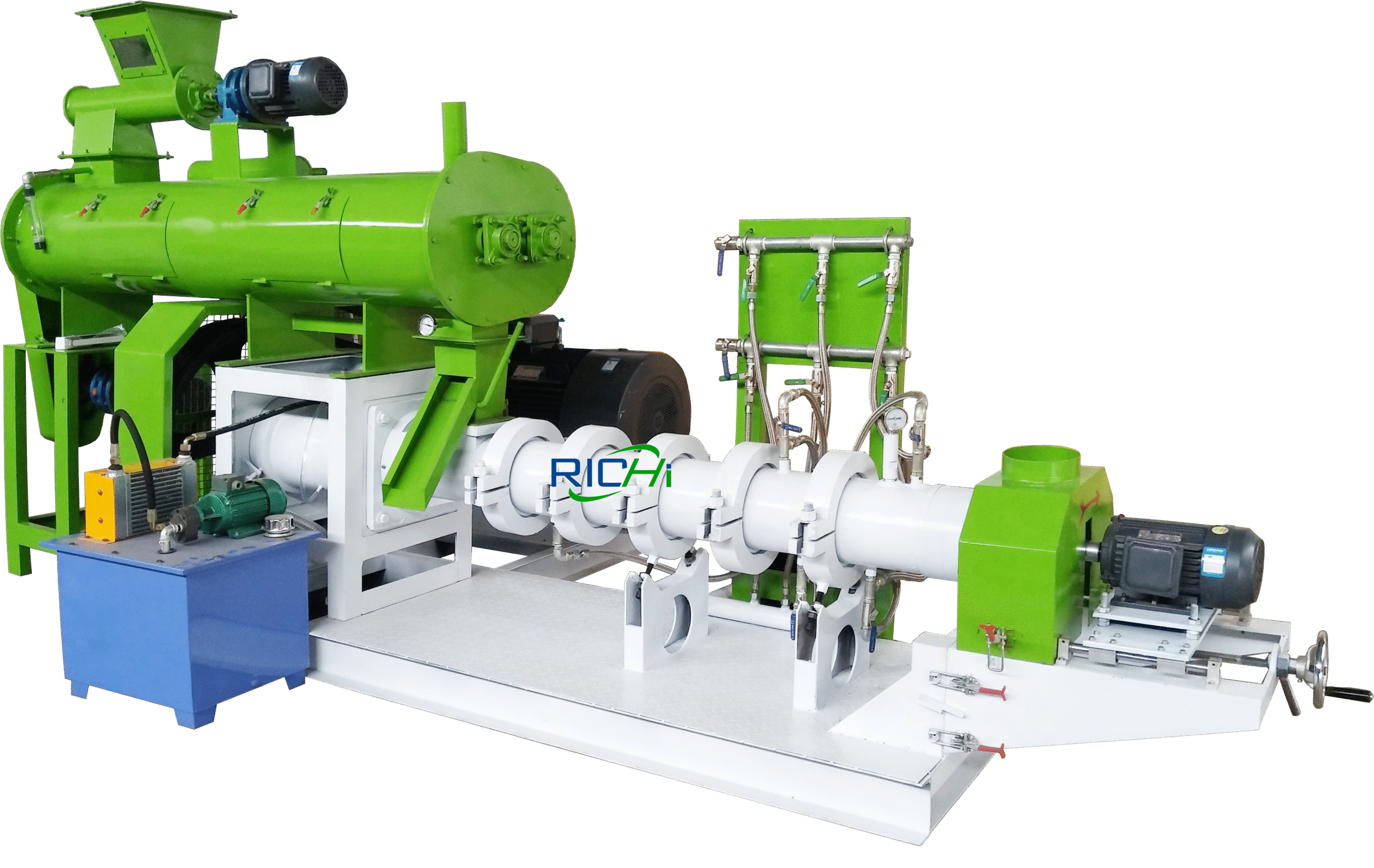
Single screw floating fish feed extruder machine
Single-screw extrusion extruder machine is a device specially used for the production of floating fish feed pellets. It extrudes and puffs the raw materials under high temperature and high pressure through a rotating screw, so that the feed pellets can float on the water surface and facilitate fish feeding. Its structure is relatively simple, easy to maintain, relatively low cost, and can be widely used in small and medium-sized aquaculture farms and fish feed farms, suitable for the production of common floating fish feed. It is divided into two processes: dry method and wet method:
Dry method: The raw materials need to be added with water, but no conditioning is required before entering the extruder bin. The extruder heat is completely generated by mechanical extrusion, and no steam system is required. The equipment is relatively simple, the operation and maintenance are relatively convenient, the cost is low, but the output is relatively limited, which is suitable for small and medium-sized users.
Wet method: The raw materials need to be pre-conditioned before entering the extruder bin. With the help of steam or water to increase the temperature, the starch is pre-gelatinized, the protein is denatured, and the raw materials are softened, which improves the extruder quality. The produced feed particles are smoother and of better quality. It is suitable for large-scale production of medium and large feed processing plants and aquaculture farms.
The following are the specific parameters of the two processes:
| Parameters | Dry extruder machines (DGP Series) | Wet extruder machines (DSP Series) |
| Model | DGP-90B / DGP-120B / DGP-160B | DSP-90B / DSP-135B |
| Main Motor Power (kW) | 37 / 55 / 90 | 37 / 75 |
| Feeding Motor Power (kW) | 0.75 / 2.2 / 3 | 7.5 / 7.5 |
| Cutting Motor Power (kW) | 0.55 / 1.1 / 1.5 | 1.1 / 1.5 |
| Conditioning Motor Power (kW) | – (No Pre-Conditioning Needed) | 1.1 / 2.2 |
| Screw Diameter (mm) | 90 / 120 / 160 | 90 / 135 |
| Overall Dimensions (mm) | 2100×1450×1350 / 2400×1950×1600 / 3100×2650×1800 | 2600×1600×1900 / 3750×1980×1950 |
| Output (Ton/Hour) | 0.2–0.4 / 0.5–0.6 / 0.8–1.0 | 0.5–0.6 / 0.8–1.0 |

Twin screw floating fish feed extruder machine
Fish feed twin screw extruder machine is a highly efficient granulation equipment commonly used for processing fish feed. Its working principle is to extrude the material from the feed port to the discharge port through two rotating screws, and at the same time heat and pressurize the material to turn it into fluid. This equipment is widely used in aquaculture and other industries because of its high efficiency, flexibility and high-quality production characteristics, and is widely concerned and loved by various industries.
Floating fish feed extruder has high capacity and low energy consumption. Fully kneaded screw technology is used to ensure uniform feed pellets and improve the granular curing effect with an efficient tempering device. The equipment operates stably and safely, has a low failure rate, and can also produce a variety of aquatic feed.
The following are its detailed technical parameters:
| Model | Production Capacity (tons/hour) | Main Motor Power (KW) | Screw Diameter (mm) | Matching Differential Speed Regulator Model Power |
| RCPH120*2 | 1 – 2 | 75 | 120 | DDC40×30 – 244 11 kW |
| RCPH120*2 | 3 – 4 | 90 | 120 | DDC40×30 – 244 11 kW |
| RCPH150*2 | 4 – 5 | 160 | 150 | DDC50×30 – 244 11 kW |
| RCPH150*2 | 6 – 7 | 200 | 150 | DDC50×30 – 244 11 kW |
| RCPH185*2 | 8 – 10 | 315 | 185 | DDC50×30 – 300 15 kW |
| RCPH185*2 | 10 – 12 | 355 | 185 | DDC50×30 – 300 15 kW |
Other auxiliary equipment of fish feed manufacturing plant
In addition to the main production machines, a complete fish feed manufacturing plant also relies on a variety of auxiliary equipment to ensure smooth, efficient, and high-quality production. These supporting machines play vital roles in material preparation, processing, cooling, and final packaging. Below, we briefly introduce several commonly used auxiliary devices.
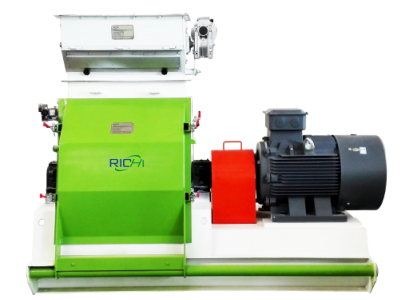
Feed crusher
Feed crusher is suitable for crushing various feed raw materials, such as corn, wheat, beans, crushed cakes, etc. Widely applicable to large and medium-sized livestock and poultry and aquatic feed enterprises. In addition, the RICHI SFSP series water drop hammer crusher adopts an advanced water drop crushing chamber design, a reasonable secondary crushing structure, and can efficiently crush aquatic feed raw materials.
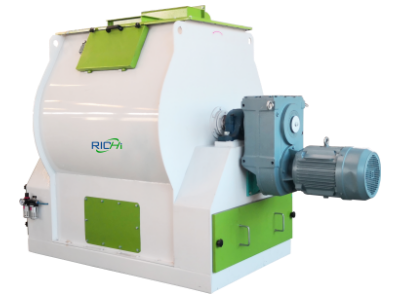
Feed mixer
The feed mixer is used to evenly mix the crushed raw materials to ensure uniform proportions of each component. Moreover, the RICHI mixer adopts a novel rotor structure, with a mixing uniformity of up to 97.7%, and a short mixing time.
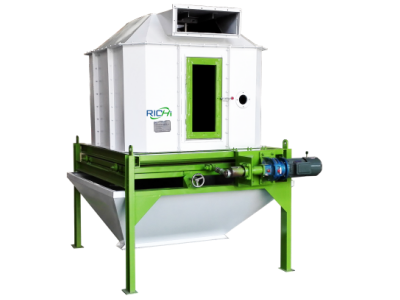
Feed Cooler
The feed cooler mainly cools the newly extruded hot pellets to avoid cracking of the pellets due to quenching. In this way, it can effectively protect the structure of feed pellets and improve the quality of feed.
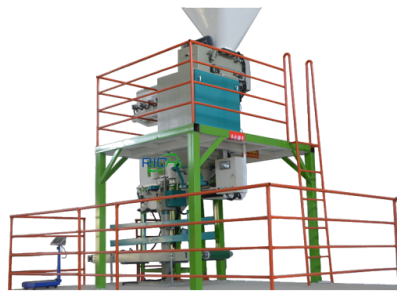
Feed packaging machine
The feed packaging machine automatically completes the packaging of feed pellets, which is highly automated and adapts to the needs of large-scale production, and has attracted the attention and love of many fish feed factories.
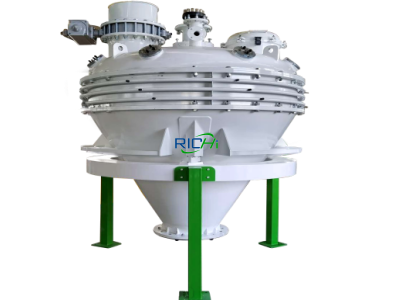
Vacuum spraying
Vacuum spraying equipment is mainly used to spray nutrients such as oil, enzyme preparations, etc. on the surface of fish feed particles. The equipment adopts a sealed design and operates under a negative pressure environment, so that the spraying liquid can penetrate into the particles, spray more evenly, and adsorb more firmly. Compared with traditional spraying methods, vacuum spraying can greatly improve the nutrient preservation rate and particle quality, and is an important part of fish feed production.

Feed dryer machine
Fish feed dryer machine is an indispensable and important equipment in the fish feed production line. It is mainly used to quickly and evenly dry the high-temperature and moist feed pellets that have just been extruded. Through drying, the moisture content of the pellets can be effectively reduced, the storage stability and transportation adaptability of the pellets can be improved, and mold and deterioration can be prevented.
Production technology of fish feed manufacturing plant
The main function of the fish feed manufacturing unit equipment is to process various raw materials into feed suitable for fish feed through mixing, crushing, granulation and other processes. Next, I will take the 5T/H floating fish feed production line as an example to briefly introduce how to use the production process of this production line to make fish feed pellets.
Fish feed manufacturing plant process flow: receiving part → crushing part → ingredients and mixing part → micro-pulverizing part → mixing part → extruder and drying part → packaging part
Equipment configuration of this feed production line: Feed crusher → bucket elevator → feed mixer → ultra-micro crusher → floating fish feed machine → dryer → sprayer → countercurrent cooler → screening → packaging machine
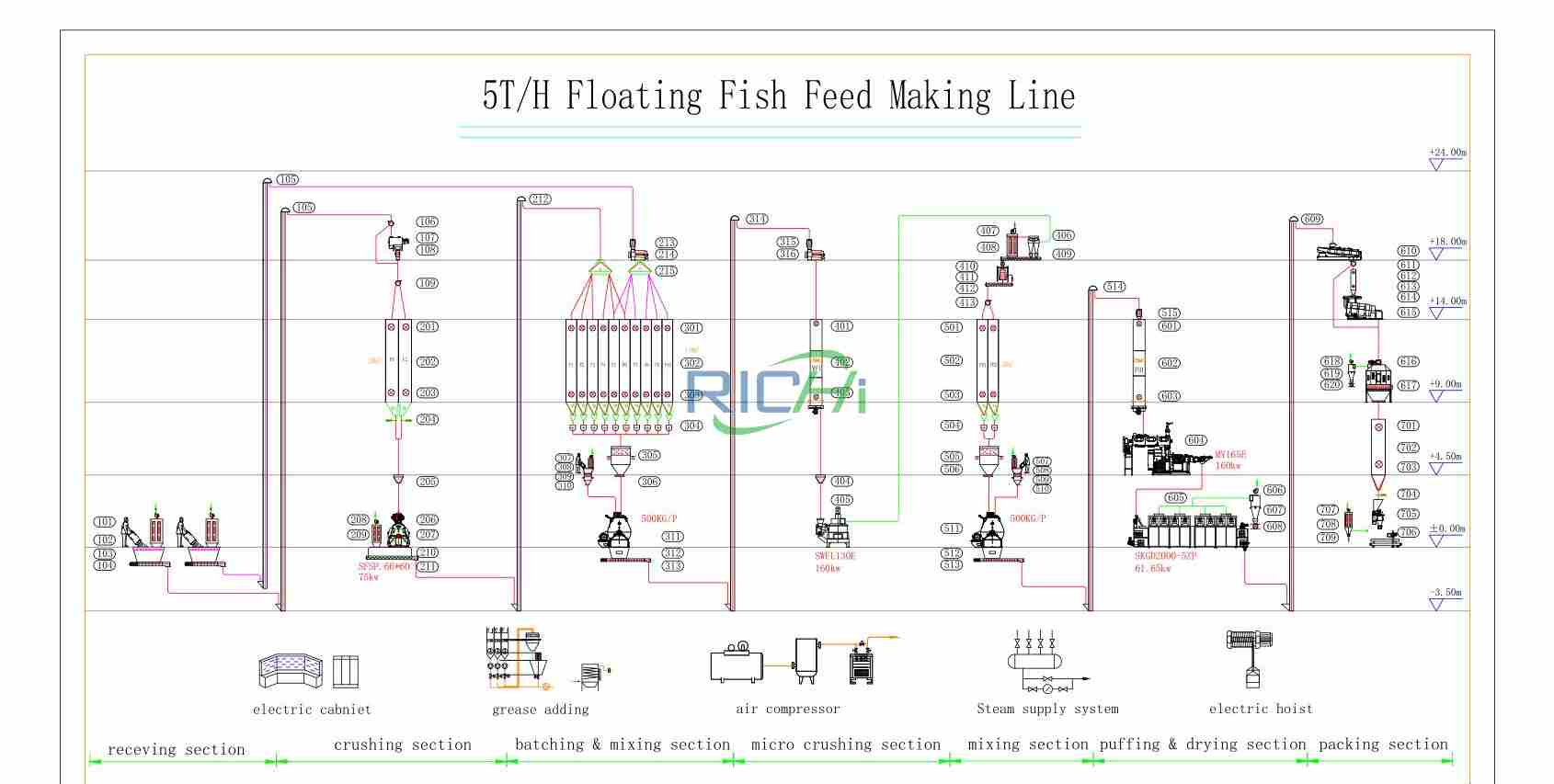
The following is the detailed production process:
01 Raw material storage and conveying system
Including raw material silos, conveyor belts, etc., used to store and convey various raw materials.
02 Raw material reception and cleaning
The raw materials mainly include two forms: powder and pellets. The powder can directly enter the dosing silo, and the pellets need to be coarsely crushed. The raw materials need to be removed through cleaning equipment to ensure the quality of the raw materials.
03 First ingredients and mixing
The first ingredients are mainly the preparation of materials with relatively large amounts in the formula, and are completed by electronic ingredients scales. After batching, enter the first mixing, reduce the range of variation in material pellet size and improve the working condition of the crusher.
04 Second crushing
Due to the poor digestibility of aquatic animals, the feed crushing pellet size is required to be very fine. After the second crushing process is completed, enter the rotary grading screen to remove the crude fibers from the feed.
05 Second mixing
After passing through the second batching, each raw material enters the second mixer, and adds trace additives and liquids.
06 Conditioning and extruder
The material is steamed and cooked under high temperature, high humidity and high pressure, and changes in physical and chemical properties occur, forming puffed feed. Puffed feed has the advantages of high gelatinization of starch, easy to digest protein, and good palatability.
07 Cooling, drying and screening system
Used to cool, screen and dry the granulated feed to prevent the feed from deteriorating. The feed is screened to remove unqualified pellets and package them for easy storage and transportation.
08 Product grading and packaging
The cooled material is lifted, broken and then entered into a grading screen for grading. The final product directly enters the finished product warehouse and then weighs and packages.

The following are related case projects of RICHI Machinery. I hope it will be helpful to you. If you are interested in our equipment, please leave a message and we will provide you with the best fish feed production line solution.
Related case projects of fish feed manufacturing plant
In the field of aquaculture, fish feed factories of different sizes have diverse production needs and operation models. RICHI focuses on fish feed production plant engineering, offering not only advanced equipment but also competitive solutions tailored to local markets. With a strong reputation for quality and reasonable floating fish feed machine price, RICHI’s products have been exported to more than 150 countries and regions including Japan, Canada, Germany, Russia, the United Kingdom, Australia, and Chile, serving thousands of customers. Many of these projects have become benchmark cases in their respective regions.

1-2T/H fish feed processing line in Russia
- Country: Russia
- Date: July 28, 2021
- Production capacity: 1-2T/H
- Main equipment of this line: fish feed hammer mill, fish feed mixer, fish feed extruder machine, dryer, packaging machine and other auxiliary equipment
- Main raw materials: soybean meal, corn, rice bran, fish meal, etc.
- Installation period: 10-15 days
- Number of auxiliary installation engineers: 8-10 people
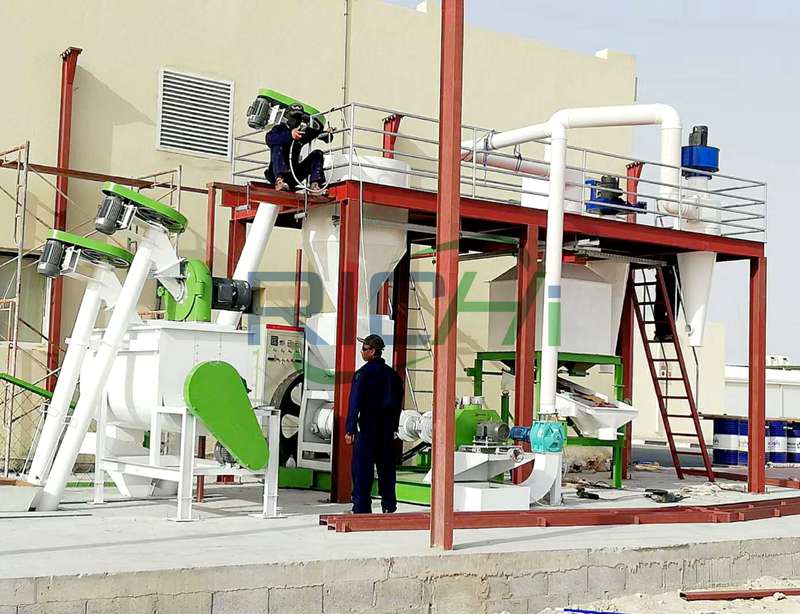
1-1.5T/H floating fish feed manufacturing plant and 2TPH fish feed pellet line
- Country: Uzbekistan
- Production capacity: 1-1.5T/H
- The bank’s main equipment: high-quality fish feed hammer mill, feed mixer, fish feed extruder machine, oven, spraying equipment, packaging machine and other auxiliary equipment
- Main raw materials: corn, wheat, soybean meal, fish meal, black meal and other grains.
- Installation period: 5-10 days
- Number of auxiliary installation engineers: 5-10 people
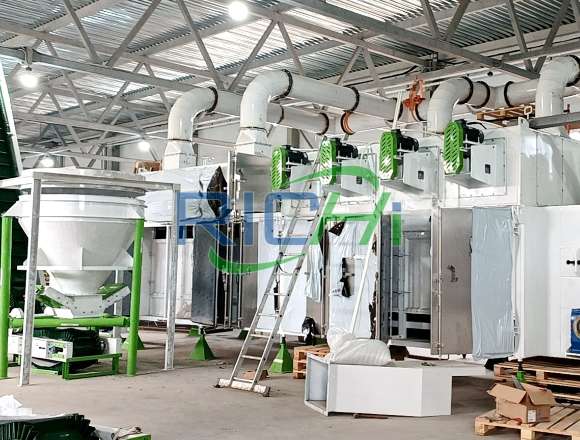
2T/H fish feed manufacturing plant for sale in Chile
- Country: Chile
- Date: September 17, 2024
- Production capacity: 5T/H
- Main equipment of this line: high-quality fish feed hammer mill, feed mixer, fish feed extruder machine, dryer, spraying equipment, packaging machine and other auxiliary equipment
- Main raw materials: corn, soybean meal, fish meal, wheat flour and other conventional feed grains
- Installation period: 12-15 days
- Number of auxiliary installation engineers: 10-15 people
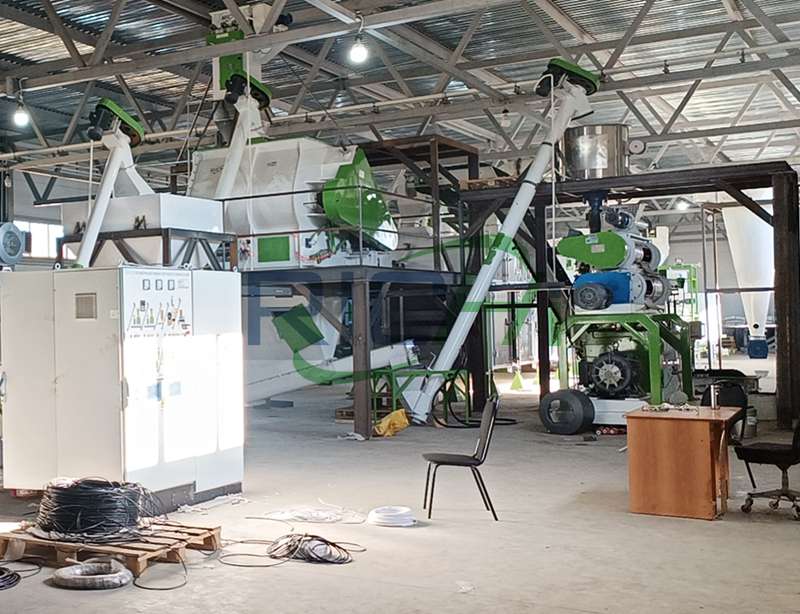
Bangladesh 5T/H floating fish feed manufacturing plant
- Country: Bangladesh
- Production capacity: 5T/H
- The main equipment of this line: fish feed hammer mill, high-efficiency feed mixer, floating fish feed pellet extruder machine, dryer, sprayer and other auxiliary equipment.
- Main raw materials: corn, soybean meal, fish meal, black powder and other grains
- Installation period: 10-15 days
- Number of auxiliary installation engineers: 10-15 people
How to buy a satisfactory fish feed manufacturing plant?
When we prepare for a purchase, this requires a combination of factors to ensure that the selected equipment meets production needs and provides high-quality feed. Here are some things to note when choosing, I hope it can help you.
To clarify your own needs
First, you need to determine the purpose of producing fish feed. Is it to meet your own fish farming needs? If the production scale is large, it is recommended to choose a wet fish feed extruder machine, because it has high efficiency, large output, and produces high-quality pellets—ideal. At the same time, understanding the fish feed pellet machine price will help you make a cost-effective decision based on your budget and production goals.
Choose the right raw materials
Different raw materials require different processing machines. You can choose the right machine according to your raw material source. For example, if your main raw materials are corn flour, rice bran, etc., you can consider using a dry or wet extruder machine.
Consider the types of farmed fish
Different types of fish have different dietary habits and require different sizes and types of feed pellets. For example, tilapia prefer to feed on the water surface, so they need floating fish feed pellets, suitable sizes of 2-3mm.
Pay attention to the quality of the equipment
The material and maintenance of the machine are important factors in judging the quality of the machine. Quality fish feed machines are usually made of high-quality stainless steel to provide strength and maintain hygiene.
Choose a professional manufacturer
The professionalism of the manufacturer is crucial. It is extremely critical to choose a brand with good after-sales service and reputation. RICHI Machinery can not only provide high-quality equipment, but also provide complete after-sales service and technical support.
Go to the factory for field inspection
If possible, it is recommended to go to the factory for field inspection directly. This not only provides an intuitive understanding of the production process and quality of the equipment, but also allows for face-to-face communication with engineers to ensure that the equipment can meet your specific needs.
FAQs
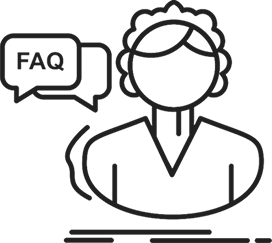
What raw materials can be used in the fish feed manufacturing plant?
The raw material selection of fish feed manufacturing units is very important. It will affect the nutritional value of the feed and the growth effect of fish. So which raw materials can we choose as raw materials for making fish feed pellets?
(1) Choose some protein raw materials, such as fish meal and soybean meal. They are rich in protein, are one of the important nutrients in fish feed, and are relatively low in price. They are common protein supplements in fish feed.
(2) Some staple food raw materials rich in energy are also extremely important. These energy raw materials mainly provide the energy required for fish growth. Corn is rich in starch and is the most commonly used energy source in fish feed; wheat provides carbohydrates to help fish metabolism; wheat bran is rich in fiber, which helps digestion; rice bran provides energy and fiber, which helps fish grow strongly.
(3) Fats and oils are important sources of fish energy, including fish oil, which is rich in unsaturated fatty acids and helps fish growth and health.
(4) Minerals are crucial to the health and growth of fish, such as calcium, phosphorus, iron, zinc, etc., which help fish bone development and metabolism.
Nutritional characteristics of fish feed pellets
(1)The effective energy value of fish feed pellets is high, so it is easy to prepare high-quality fish feed using various materials as raw materials.
(2)Fish feed pellets are rich in vitamins, among which vitamin B12 and vitamin B2 are very high. It also contains fat-soluble vitamins such as vitamins A, D, and vitamin E.
(3)Fish feed pellets are a good source of minerals, with high calcium and phosphorus content and appropriate proportions. In addition, the selenium content of fish meal is also very high.
What is the application prospect of fish feed production plant equipment in modern aquaculture?
With the continuous advancement of science and technology, fish feed manufacturing unit equipment is becoming more and more widely used in aquaculture. By adopting advanced production line equipment, farmers can realize the automation and intelligence of feed production, improve feed quality and production efficiency, and thus increase breeding benefits. At the same time, production line equipment can also produce feed of different specifications and nutritional components according to different stages of fish growth and nutritional needs, providing strong guarantees for the healthy growth of fish.
As an important part of the aquaculture industry, fish feed manufacturing unit equipment is of great significance to improving feed quality and production efficiency and promoting the healthy development of the aquaculture industry. With the continuous advancement of technology and the continuous expansion of application fields, feed production line equipment will play a more important role in the future.
Is the installation and debugging of the equipment complicated?
We have a professional technical team to provide customers with a comprehensive installation and debugging service.Before the equipment is shipped, technicians will conduct comprehensive pre-installation and commissioning of the equipment to ensure that the equipment is not damaged during transportation and can be installed and in place quickly after arriving at the customer’s site.After arriving at the site, technicians will install and fine debugging of the equipment according to the customer’s site conditions and production needs, and at the same time provide detailed training to the customer’s operators to ensure that they are proficient in the operation and maintenance skills of the equipment.We will follow up the entire installation and debugging process to ensure that the equipment is put into production smoothly.
Is the maintenance of equipment difficult?
Our feed production line design focuses on ease of maintenance, and key components are modularly designed for easy disassembly and replacement.At the same time, detailed operating manuals and maintenance guides are randomly equipped to provide customers with comprehensive maintenance guidance.In addition, we have established a complete after-sales service system, regularly visit customers, and provide customers with technical support and maintenance suggestions.If the equipment fails, our after-sales team will respond in the shortest time, providing remote guidance or on-site repair services to ensure the equipment is operating normally and reduce downtime.
Can the production capacity of the equipment be adjusted according to demand?
Sure.When designing our feed production line, we fully consider the scalability of production capacity. Customers can easily achieve capacity improvement by adding equipment modules and upgrading key components according to actual production needs.For example, the number of ingredients scales can be increased, the capacity of the mixer can be expanded, the production efficiency of fish feed pelletizers can be improved, etc., to meet the company’s growing production needs.At the same time, our technical team will provide customers with professional capacity upgrade solutions and technical support to ensure the smooth progress of the upgrade process.
Can feed formula support be provided?
We not only provide advanced fish feed pellet production line equipment, but also provide customers with professional feed formula support.We have a senior animal nutrition technical team. They have rich industry experience and professional knowledge and can tailor scientific and reasonable feed formulas for customers based on the breed, growth stage, breeding environment and other factors of different animals.At the same time, we will continue to optimize and update feed formulas based on market demand and industry development trends to help customers improve the competitiveness of feed products.The following is a detailed introduction to the floating feed formula and sinking feed formula. This feed formula is for reference only:
(1) Floating feed formula
Raw materials: 15% fish meal, 38% soybean meal, 25% wheat flour, 12% rice bran, 3% fish oil, 2% calcium dihydrogen phosphate, 3% premix (including vitamins, minerals, etc.).
(2) Sinking feed formula
Raw materials: 12% fish meal, 35% soybean meal, 22% corn meal, 18% bran, 5% meat and bone meal, 2% vegetable oil, 3% calcium hydrogen phosphate, premix (including vitamins, minerals, etc.).

Why choose RICHI Machinery
Improved industrial chain
As a local enterprise, RICHI Machinery has built its own R&D, production and sales system. 30+ models of equipment cover various fields such as granulation, grinding, and drying. It has passed international certifications such as ISO and CE. It has business covering more than 100 countries and has a total of 2,000 customers. It has dual guarantees of quality and delivery capabilities.
Comprehensive and thoughtful service
The professional team conducts in-depth research on raw material characteristics, production capacity goals and site conditions, from solution design to equipment delivery and customization, adapts to the needs of small and medium-sized breeding farms to large factories, refuses to “over-configure”, and provides cost-effective “precision” solutions.
Quality guaranteed
Strictly implement the ISO9001 standard, implement quality accountability and production safety management, and achieve full process traceability from design to manufacturing through QC quality control, SPC statistical process control and other means, eliminate quality hidden dangers, and ensure equipment durability and stability.
Reliable delivery and quick production
Following the four-fold inspection process of “order verification → factory quality inspection → boxing re-inspection → scientific packaging”, engineers guide infrastructure, installation and commissioning on site until the production line meets the standards and accepts it, and use standardized processes to ensure the efficient implementation of the project and shorten the production cycle.
Complete after-sales guarantee system
The technical team of nearly 100 people covers the entire process of consultation, design, installation and maintenance, provides customized technical solutions and operation training for the fish feed manufacturing plant, regularly reviews the equipment operation status after delivery, quickly responds to after-sales needs, and helps the production line to operate stably for a long-term and stable manner. You can find us on YouTube.
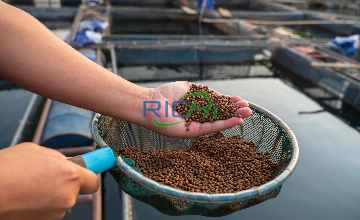
Five core advantages of RICHI Machinery
Improved industrial chain
Comprehensive and thoughtful service
Quality guaranteed
Reliable delivery and quick production
Complete after-sales guarantee system





